 |
 |
 |
| |
The Impact of Weight Gain and Sex on Immune Activation Following Initiation of ART
|
| |
| |
There was a THEMED DISCUSSION: WEIGHT GAIN DURING ART where 8 CROI presentations were discussed
Link to webcast Discussion period
http://www.croiwebcasts.org/console/player/41235?mediaType=audio&
CABOTEGRAVIR IS NOT ASSOCIATED WITH WEIGHT GAIN IN HIV-NEGATIVE INDIVIDUALS: HPTN 077 (ABSTRACT 34)
Raphael J. Landovitz
University of California Los Angeles, Los Angeles, CA, USA
THEMED DISCUSSION LEADER
Jane A O'Halloran
Washington University in St Louis, St Louis, MO, USA
RISK FACTORS FOR EXCESS WEIGHT GAIN FOLLOWING SWITCH TO INTEGRASE INHIBITOR–BASED ART (ABSTRACT 669)
Jordan E Lake
University of Texas Health Science Center Houston, Houston, TX, USA
GREATER WEIGHT GAIN AMONG TREATMENT-NAIVE PERSONS STARTING INTEGRASE INHIBITORS (ABSTRACT 670)
Kassem Bourgi
Indiana University School of Medicine, Indianapolis, IN, USA
WEIGHT GAIN DURING TREATMENT AMONG 3,468 TREATMENT-EXPERIENCED ADULTS WITH HIV (ABSTRACT 671)
Grace A. McComsey
University Hospitals Cleveland Medical Center, Case Western Reserve University, Cleveland, OH, USA
INTEGRASE STRAND TRANSFER INHIBITORS ARE ASSOCIATED WITH WEIGHT GAIN IN WOMEN (ABSTRACT 672)
Anne Marie Kerchberger
Emory University, Atlanta, GA, USA
THE IMPACT OF WEIGHT GAIN AND SEX ON IMMUNE ACTIVATION FOLLOWING INITIATION OF ART (ABSTRACT 673)
Sara H Bares
University of Nebraska Medical Center, Omaha, NE, USA
-------------------------------
Reported by Jules Levin
CROI 2019 March 4-7 Seattle
Sara H. Bares1, Laura M. Smeaton2, Vincent Vu2, Sarah E. Scott3, Beth A. Smith3, Catherine Godfrey4, Grace A. McComsey3
1University of Nebraska Medical Center, Omaha, NE, 2Harvard T.H. Chan School of Public Health, Boston, MA, 4Division of AIDS, NIAID, Bethesda, MD, 3University Hospitals Cleveland Medical Center and Case Western Reserve University School of Medicine, Cleveland, OH

THE IMPACT OF WEIGHT GAIN AND SEX ON IMMUNE ACTIVATION FOLLOWING INITIATION OF ART
Author(s):
Sara H. Bares1, Laura M. Smeaton2, Vincent Vu2, Beth A. Zavoda-Smith3, Sarah E. Scott3, Catherine Godfrey4, Grace A. McComsey3
1University of Nebraska Medical Center, Omaha, NE, USA,2Harvard T.H. Chan School of Public Health, Boston, MA, USA,3Case Western Reserve University, Cleveland, OH, USA,4DAIDS, NIAID, Bethesda, MD, USA
Program Abstract
Immune activation persists despite suppressive antiretroviral therapy (ART) and may be affected by sex or body composition. We hypothesized that weight gain, sex and BMI would be associated with changes in immune activation following ART initiation and explored these relationships in a selected subset of women and men initiating ART in two large randomized ACTG trials (A5202 and A5257).
A purposeful sampling design selected participants who achieved virologic suppression on ART and either maintained weight within +/- 0.5 kg/m2 ('maintainers') or gained 2.6-6.4 kg/m2 ('gainers') from baseline to 96 weeks. We measured IL-6, sTNF-RI and II, IP-10, hsCRP, sCD14 and sCD163 at weeks 0 and 96. Multivariable linear regression explored associations of weight gain (gainers vs maintainers), sex, and pre-ART BMI with outcomes of pre-ART biomarker concentrations and changes from baseline to week 96, adjusting for baseline age, race/ethnicity, ART regimen, CD4 count and HIV-1 RNA.
340 participants were selected; median pre-ART age 42 years, CD4+ cell count 273 cells/mm3, HIV-1 RNA 4.7 log10 copies/mL; 49% were women, 33% white, 42% black, and 24% Hispanic. Pre-ART biomarker concentrations were similar in women and men (data not shown). While pre-ART BMI was similar between gainers and maintainers (overall and within sex), gainers had significantly lower pre-ART CD4 vs maintainers. In adjusted models among those with normal pre-ART BMI, pre-ART IL-6, sTNF-RII, IP-10, and sCD163 were higher for gainers versus maintainers. Association of weight gain on week 96 changes of these 4 biomarkers differed by sex; women who gained weight had smaller declines in biomarkers compared to men who gained (see Table). For IL-6, for women, gaining weight was associated with attenuating changes by 0.05 (difference between model-based means), whereas for men, gaining weight was associated with increasing changes by 0.13. For sTNF-RII, the association between weight gain and changes in sTNF-RII also varied by pre-ART BMI.
Higher pre-treatment immune activation markers are significantly associated with weight gain following ART initiation even after controlling for pre-ART CD4 counts. Weight gain attenuates the decline in several immune activation markers following ART initiation among women; thus, women may be at increased risk for complications of weight gain. Identifying individuals at risk of weight gain may allow for targeted investigation of preventive interventions.
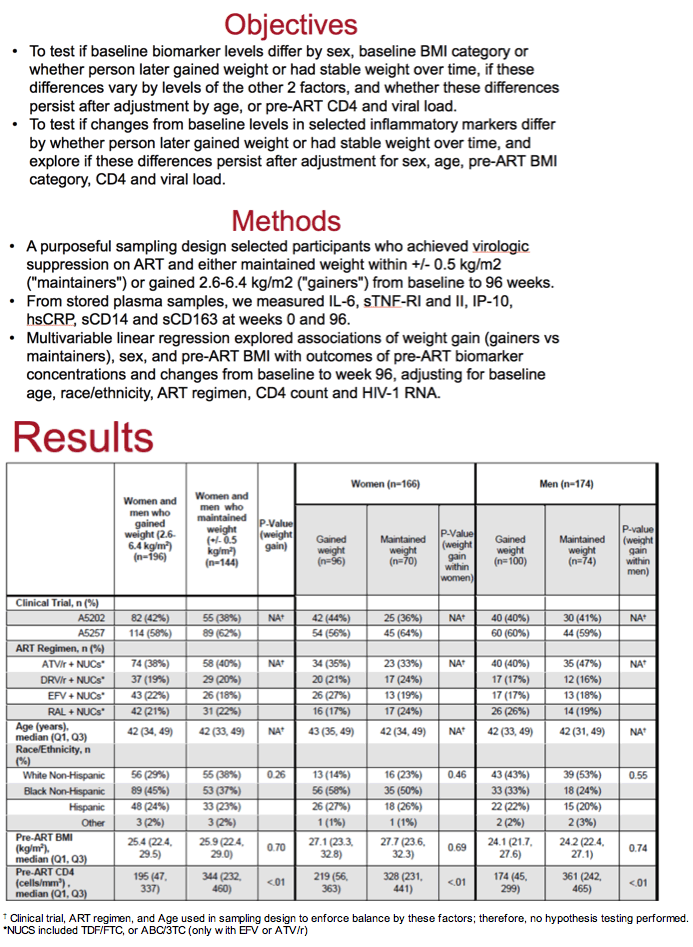
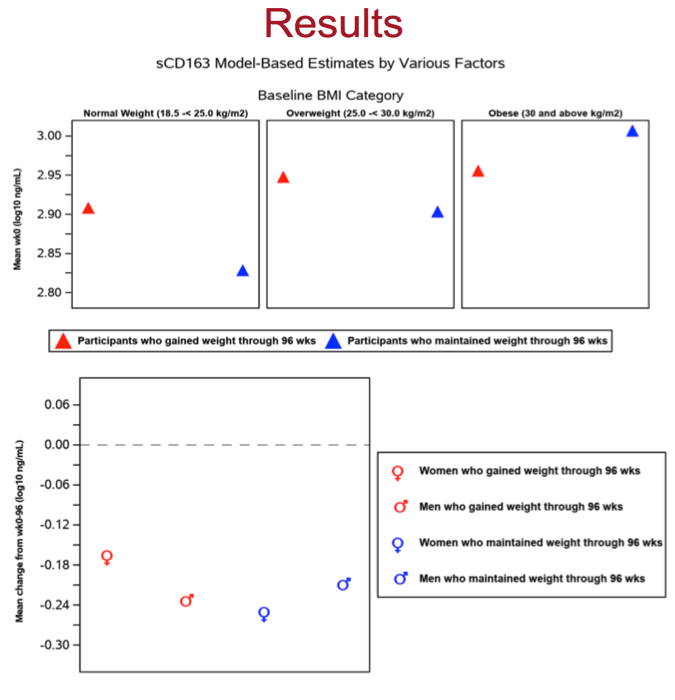
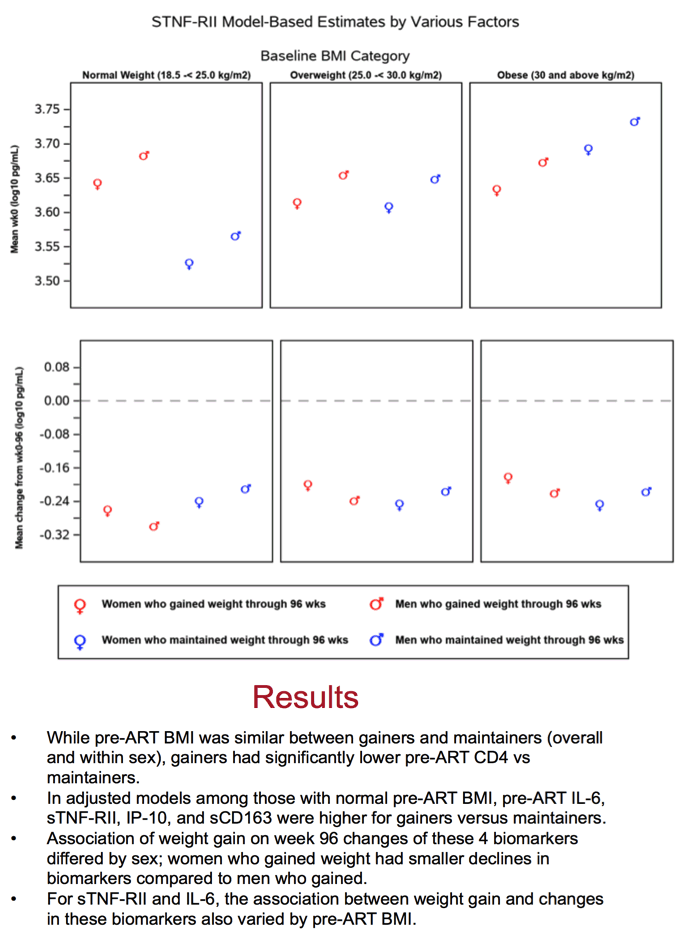
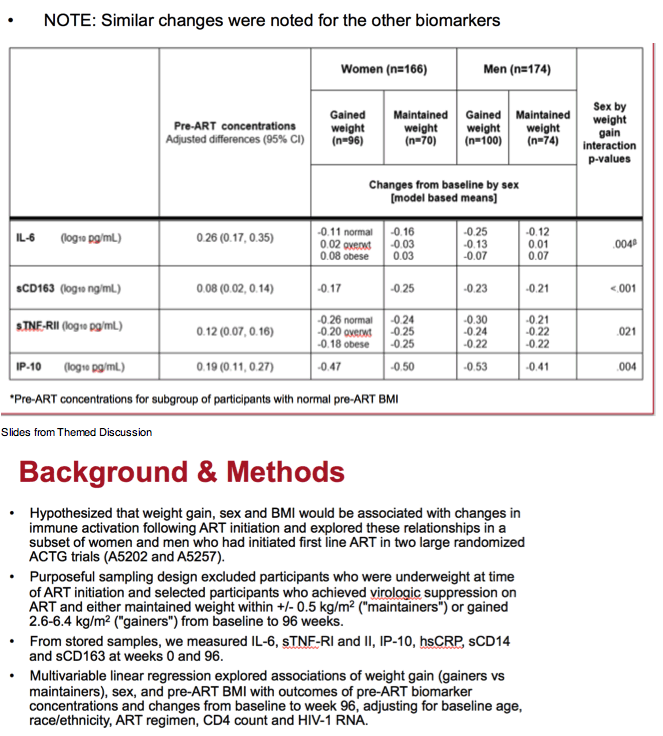
On behalf of my coauthors, we are grateful for the opportunity to share our data with you today.
We are going to continue with the weight gain theme but shift the discussion a bit towards the relationship between weight gain following ART initiation and markers of immune activation.
Based on prior work by our group, we hypothesized that weight gain, sex and BMI would be associated with changes in immune activation following ART initiation and explored these relationships in a subset of women and men who had initiated first line ART in two large randomized ACTG trials, A5202 and A5257.
Purposeful sampling design excluded participants who were underweight at the time of ART initiation and selected participants who achieved virologic suppression and either maintained weight within 0.5 kg/m2 (we called these “maintainers”) or gained between 2.6-6.4 kg/m2 (we called these gainers) from baseline to 96 weeks.
From stored samples, we measured IL-6, sTNF-RI and II, IP-10, hsCRP, sCD14 and sCD163 at weeks 0 and 96.
Multivariable linear regression explored associations of weight gain, sex, and pre-ART BMI with outcomes of pre-ART biomarker concentrations and changes from baseline to week 96, adjusting for baseline age, race/ethnicity, ART regimen, CD4 count and viral load.
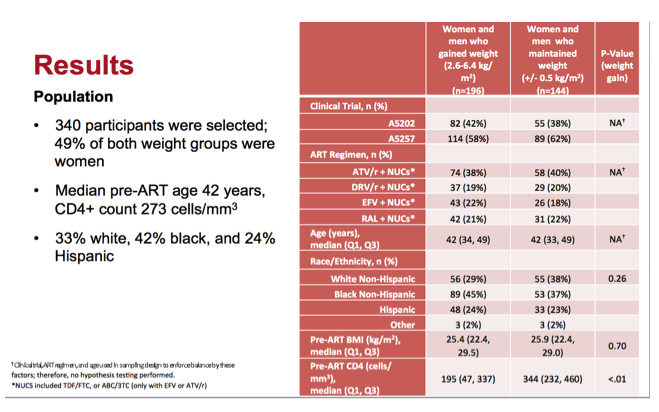
A total of 340 participants were selected. All available women and a similar number of men were sampled.
Median pre-ART age was 42 years and median pre-ART CD4 cell count was 273 cells/mm3.
33% were white, 42% black and 24% Hispanic.
This table displays the baseline characteristics for participants who gained weight and participants who maintained weight. Clinical trial, ART regimen, and age were used in the sampling design to enforce balance by these factors so hypothesis testing was not performed for these categories. There were no significant differences in race/ethnicity and pre-ART BMI between the groups, but you will note that those who gained weight had a significantly lower pre-ART CD4 cell count than those who maintained weight.

We have selected data for two of the biomarkers; come see poster 673 for more details about the biomarkers not presented during this session.
The top panel shows the model-based estimated mean pre-ART sCD163 by baseline BMI category. Red triangles represent participants who gained weight and blue triangles represent participants who maintained weight. You will note that participants with pre-ART BMIs in the normal and overweight categories who gained weight (red triangles) had higher pre-treatment sCD163 levels. In other words, among non-obese participants, higher pre-treatment sCD163 levels were significantly associated with weight gain, even after controlling for pre-ART CD4 counts
(Note but do not need to say out loud: among those who started obese, there’s an interaction à those who maintained weight had higher pre-ART biomarker levels compared to those who gained weight; also à no significant association with sex)
The bottom figure illustrates the estimated mean changes in sCD163 from 0 to 96 weeks. Red represents those who gained weight and blue represents those who maintained. Here, we found an association between weight gain and change in biomarker concentration that varied by sex so there are separate symbols for women who gained and maintained versus men who gained and maintained weight through 96 weeks. You will note that, among women (but not men), gaining weight was significantly associated with smaller decreases in sCD163 compared to women maintaining weight.
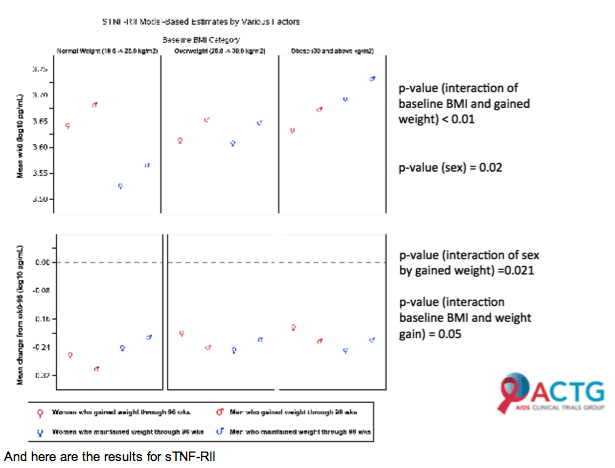
The top panel shows the model-based estimated mean pre-ART sTNF-RII level by baseline BMI category. Red symbols represent participants who gained weight and blue symbols represent participants who maintained weight. After adjusting for baseline characteristics in the multivariable model, the association between weight gain and baseline sTNF-RII concentration varied significantly by baseline BMI category (p<0.01) à among those with a baseline BMI in the normal range, the average concentration of sTNF-RII was higher for those who gained weight than for those who maintained weight but this difference became smaller for those in the overweight category and was reversed for those with a baseline BMI in the obese range – those who gained actually had lower average baseline sTNF-RII levels.
Additionally, sex and baseline sTNF-RII were significantly associated (p=0.02) à women had lower average concentrations of sTNF-RII at baseline when compared to men.
The bottom figure illustrates the estimated mean change sin levels of sTNF-RII from baseline to week 96 which varied by pre-ART BMI and by sex. As you can see, among women, gaining weight was associated with smaller decreases in sTNF-RII compared to maintaining weight…but only for overweight and obese women. For overweight and obese men, gaining weight was associated with larger declines in sTNF-RII compared to maintaining weight.

|
| |
|
 |
 |
|
|